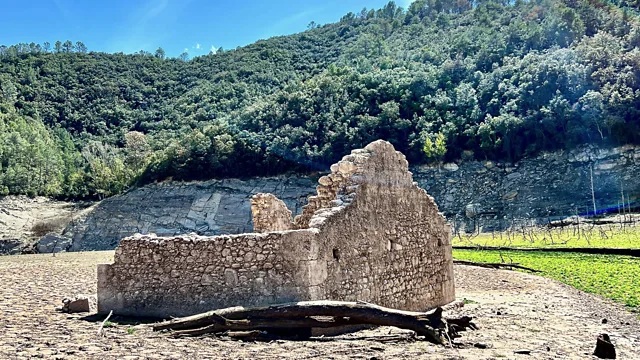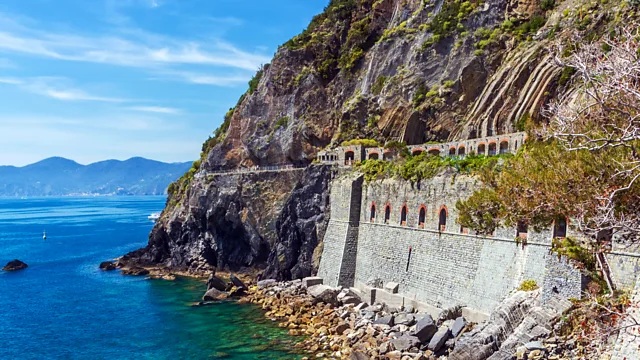
Web Desk
ISTANBUL: The world is filled with awe-inspiring natural wonders that take one’s breath away, with caves being some of the most dazzling examples of nature’s capabilities. Let’s take a look at these underground beauties from across the world
Caves are defined as underground cavities that are connected to the surface, are deep enough that they receive no daylight and have a width and height that allows at least one person to enter by crawling.
The branch of science that studies this mysterious and sometimes frightening natural formation is called speleology.
There are of course different types of caves such as karst caves, salt caves, glacial caves, sea caves and wind caves. Natural shapes such as stalactites, stalagmites, columns and travertines can form in them.
Caves can be used as natural cold storage, for the storage and maturation of cheese and oils, for mushroom cultivation, for the treatment of respiratory diseases or as military shelters.

There are creatures that live in or around them according to the seasons or continuously, and they are also very important for tourism, especially health tourism.
The fact that the temperatures of caves usually hover between 17 and 24 degrees Celsius (62 and 75 degrees Fahrenheit) and humidity rates at 40% to 80% throughout the year, and that these figures don’t tend to vary, gives caves microclimate characteristics.
Throughout history, people have benefited from caves.
After learning to use the sea for the first time in South Africa, people used sea caves as shelters, and on some continents for art or for tombs carved into rocks.
Here are a couple of touristic caves from different parts of the world that are sure to turn heads.

Son Doong
First discovered in 1991 by Ho Khanh, a native of Vietnam, the Son Doong cave in Vietnam was declared the largest cave in the world after a 2009 survey. It is so big that it has a large river of its own, a rainforest and small mountains. This distinctive place is home to its own ecosystem and climate.
The cave is at least 5 kilometers (3.1 miles) long and can reach the height of 200 meters (656 feet) in places.
According to experts, a large part of it is still waiting to be discovered.

Fingal’s Cave
Fingal’s Cave is a sea cave located on the uninhabited island of Staffa, Scotland. The cave, which has a wide arched entrance, is filled with seawater. Sightseeing tours are organized by local companies from April to September to venture out and see it.
In calm conditions, one can walk the short distance to the cave from the island, where a row of fractured columns forms a walkway just above the high-water level permitting exploration on foot.
The cave got its name from the eponymous hero of an epic poem by 18th-century Scots poet-historian James Macpherson.
In Irish mythology, the hero Fingal is known as Fionn mac Cumhaill, and it is suggested that Macpherson rendered the name as Fingal – meaning “white stranger” – through a misinterpretation of the name, which in old Gaelic would appear as Finn.
The legend of the Giant’s Causeway has Fionn or Finn building the causeway between Ireland and Scotland.

Waitomo Glowworm Caves
Waitomo Glowworm is a cave located in Waitomo on the North Island of New Zealand. It features a modern visitor center designed largely of wood at the entrance.
It was discovered by British researchers in 1884.
It is known for its population of Arachnocampa luminosa, a glowworm species found exclusively in New Zealand.
The cave is part of the waitomo streamway system that includes the Ruakuri Cave, Lucky Strike and Tumutumu Cave.
Guided tours take visitors through three different levels with the catacombs on the top level. The second level is called the Banquet Chamber, while the third and final level leads down to the cathedral, demonstration platform and the jetty.
The tour ends with a boat ride through the Glowworm Grotto, taking visitors along the underground Waitomo River where the only light comes from the tiny glowworms creating a sky of living lights.

Jeita Grotto
Jeita Grotto is located in Nahr al-Kalb Valley, north of Lebanon’s capital, Beirut. The cave is Lebanon’s national symbol and a top tourism destination, as well as an important economic and cultural icon. It was one of the top 14 finalists in a new seven natural wonders competition.
It is thought to have been inhabited in prehistoric times, and its modern discovery was made by Reverend William Thomson in 1836. Explorations continued in the following years, and some parts of the cave were opened to tourism in 1958. Closed in 1978 due to the civil war, the caves were reopened in 1995 and remain one of the country’s most important natural attractions.
It is a system of two separate, but interconnected, karstic limestone caves spanning an overall length of nearly 9 kilometers.
The lower cave can only be visited by boat since it hosts an underground river that provides fresh drinking water to more than a million Lebanese.

Phraya Nakhon Cave
Located in Thailand, the Phraya Nakhon cave can be reached by boat or by hiking on Tian Mountain, then climbing about 450 meters.
Phraya Nakhon is a large cave with a hole in the ceiling that allows sunlight to enter.
At the top of the hole is a bridge known as the “Bridge of Death” – given the name because many wild animals die after falling off it.
At certain times during select months, the sun shines directly on a pavilion in the heart of the cave.
Moaning Caverns
The Moaning Caverns is a solutional cave located in Calaveras County in the U.S. state of California. It was discovered in modern times by gold miners in 1851, but it had long been known as an interesting geological feature by prehistoric peoples.
It gets its name from the moaning sound that used to echo out of the cave, luring people to the entrance; however, after the opening was expanded by humans to allow public access, the sounds were disrupted and distorted.
The portion of the cave developed for tourists consists of a spacious vertical shaft, which is descended by a combination of stairs and a unique spiral staircase built in the early 1900s.
It is open to the public for walking tours and spelunking.
Tours are organized every hour and last 45 minutes.

Turkey’s underground wonders
In Turkey, 40% of the country’s land is suitable for cave formation and there are approximately 40,000 caves. The examination of 1,100 caves, mostly in the western and central Taurus Mountains, has been completed.
The longest cave in the country is Pınarözü in the province of Isparta, while the deepest cave is the Peynirlikönü cave in the Mersin district.
More than 30 caves around the country are open to tourism, and there are many caves for special interest groups that can only be entered with appropriate equipment and guides.

Çal Cave
It is estimated that Çal Cave, located in Trabzon province of northern Turkey, was formed in two stages and over a period of 8 million years.
The construction of its touristic aspects was completed in 2000 and it opened to tourism in 2003. According to some sources, it stands at 1,116 meters or 1,050 meters above sea level.
A stream that reaches 1 to 1.5 meters depth in rainy periods passes inside the cave. Above the cave, there is also a historical castle.
Dividing into two branches after 200 meters from its entrance, the cave is home to a small lake and a waterfall.

Ballıca Cave
It is estimated that the formation of Ballıca Cave, located in northern Turkey’s Tokat province, started about 3.5 million years ago.
The cave, which is among the largest caves in the world, is 680 meters long and 90 meters high. After entering the cave, you go up 19 meters and descend 75 meters. Open to visitors since 1995, this cave was added to the UNESCO World Heritage Tentative List in 2019.
It is one of the must-see places with its unique cave pearls, stalagmite stalactites, pools, cave roses and many other charming features.
Ice Cave
While there is no clear information about the formation of the Buz, or Ice Cave, located in the eastern province of Ağrı in Turkey, the data of some researchers show that the cave is a long axis elliptical pit, approximately 50 meters wide, 100 meters long and 8 meters deep.
It is not clear whether this pit is a meteorite crater or if it was formed after a natural structure collapsed. In the Ice Cave, basalt lava rocks and ice layers formed by the freezing of pure and clean water are observed on these rocks.
Far from daylight, these dark but attractive caves, which are just one of the thousands of extraordinary beauties of nature, are the beloved destinations of adventurers and travelers.
Undoubtedly, nature will continue to amaze us with new discoveries in the future.
Courtesy: Dailysabah
The post Underground wonders: World’s most stunning, breathtaking caves appeared first on The Frontier Post.








